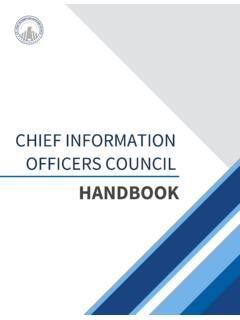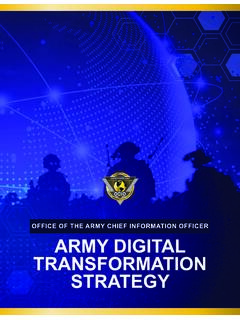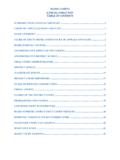Transcription of The Application Rationalization Playbook - CIO.GOV
1 The Application Rationalization Playbook An Agency Guide to Portfolio Management Application Rationalization Playbook Page 1 Table of Contents Table of Contents 1 Introduction to Version 3 Introduction to the Playbook 3 Key Terms 4 Disclaimer 4 A Six-Step Process for Application Rationalization 5 Step 1: Identify Needs and Conduct Readiness Assessment 7 Conduct Readiness Assessment 7 Identify Requirements 8 Develop a Questionnaire 8 Step 2: Inventory applications 10 Send Questionnaire 10 Validate Responses 10 Create Application Onboarding Process 10 Step 3: Assess business Value and Technical Fit 11 Review business Value and Technical Fit Responses 11 Determine Application Dependencies 11 Identify Application Duplication 11 Step 4: Assess Total Cost of Ownership 12 Determine Current-State TCO 12 Identify Cost Outliers 13 Step 5: Score applications 15 Develop a Consistent Scoring Methodology 15 Review Application Scores 15 Engage Program Offices for Transparency and Feedback 15 Step 6.
2 Determine Application Placement 17 Group applications Based on Application Scores 17 Application Rationalization Playbook Page 2 Assess Future-State TCO and Hosting Options 18 Analyze Hosting Alternatives for On-Premise applications 18 Develop Migration Strategy and Change Management Plan 20 Conclusion 23 Appendix 24 Appendix 1 - Example Inventory Sources 24 Appendix 2 - Policies and Guidelines 24 Appendix 3 - business Value Sample Questions 26 Appendix 4 - Technical Fit Sample Questions 28 Appendix 5 - The Application Rationalization Data Dictionary 29 Application Rationalization Playbook Page 3 Introduction to Version The Application Rationalization Playbook is designed to be an iterative document that evolves over time to reflect agency learning and a changing federal information technology (IT) landscape.
3 Since the Playbook s original release, many agencies have kicked-off their own Application Rationalization efforts, stress-tested the plays at their agencies, and provided ample feedback and suggestions to improve the Playbook . This updated version incorporates feedback and input based on agency experience, sharpens and clarifies concepts, and removes redundant or unnecessary language. Specifically, there is added focus on the principles of Organizational Change Management (OCM), new agency case studies and lessons learned, and updates based on new Office of Management and Budget (OMB) policy and Administration guidance.
4 It also includes information on the Application Rationalization Data Dictionary, which aims to help agencies strategically and systematically identify business applications and determine which should be kept, replaced, retired, or consolidated. Introduction to the Playbook This Playbook is a practical guide for Application Rationalization and IT portfolio management. Application Rationalization is the effort to strategically identify business applications across an organization to determine which should be kept, replaced, retired, or consolidated. This includes developing a detailed inventory, with attributes and functionality, determining business value and total cost of ownership (TCO), and then comparing or rationalizing that inventory of applications as a whole to eliminate redundancies, lower costs, and maximize efficiency.
5 Application Rationalization helps Portfolio Managers improve their agency s approach to IT modernization. There is no one-size-fits-all Application Rationalization process, rather agencies should tailor their approach to fit mission, business , technology, human capital, and security needs. Application Rationalization drives improved IT portfolio management capabilities, empowers leaders to make better decisions, and enhances the delivery of key mission and business services. Successful Application Rationalization efforts require buy-in from critical stakeholders across the enterprise, including senior leaders, IT staff, cybersecurity experts, mission and program owners, financial practitioners, acquisition and procurement experts, and end user communities.
6 Rationalization efforts rely on leadership support and continual engagement with stakeholders to deliver sustainable change. This Playbook provides simplified steps that break Application Rationalization down into component parts and it addresses challenges and opportunities for IT leaders approaching Application Rationalization for the first time. This Playbook is designed to be iterative, and agencies are encouraged to collaborate and share best practices and lessons learned from their own Application Rationalization experiences. For more information, please join the Cloud and Infrastructure Community of Practice (C&I CoP).
7 To learn and engage with C&I CoP, please email the Data Center and Cloud Optimization Initiative (DCCOI) Program Management Office (PMO) at with your request to join. Application Rationalization Playbook Page 4 Key Terms Definitions of key terms used throughout this document. Application - A software program used directly or indirectly to support the program office in delivering on a business or mission function; includes mobile applications Application owner - The individual or group within the program office that directly oversees an Application business value - Qualitative and quantitative measures of an Application s value Component - A discrete unit within a federal agency, such as a bureau or department Enterprise - An entire agency.
8 Including program offices and components Portfolio Manager - The individual or office responsible for executing Application Rationalization for the entire organization1 Program office - The office or organization within the agency that owns or operates an Application that delivers a business or mission function Technical fit - A measure of an Application s technological health Disclaimer This Playbook was developed by the Chief Information officer (CIO) Council and the Cloud & Infrastructure Community of Practice (C&I CoP), with input from key federal IT practitioners and industry representatives.
9 This document does not provide authoritative definitions of IT terms and should not be interpreted as official policy or mandated action. Rather, this Playbook supplements existing federal IT statutes and policies, and builds upon the key components of the Cloud Smart2 strategy. 1 Per FITARA and EO 13833, the CIO must be involved in all management, governance, and oversight processes related to IT. At some agencies, portfolio managers are senior members of the Office of the Chief Information officer (OCIO), such as the chief enterprise architect, while other agencies identify other stakeholders to lead their Application Rationalization efforts.
10 While agencies are free to include other stakeholders, the CIO, or a designee, must be included in the process. 2 See Application Rationalization Playbook Page 5 A Six-Step Process for Application Rationalization The six-step process outlined below is a structured, iterative approach to Application Rationalization for IT Portfolio Managers. The six steps provide discrete actions for agencies to consider when undergoing Application Rationalization . Agencies are encouraged to tailor these steps to meet organizational structures, unique requirements, and mission needs. Step 1: Identify needs and conduct readiness assessment.







